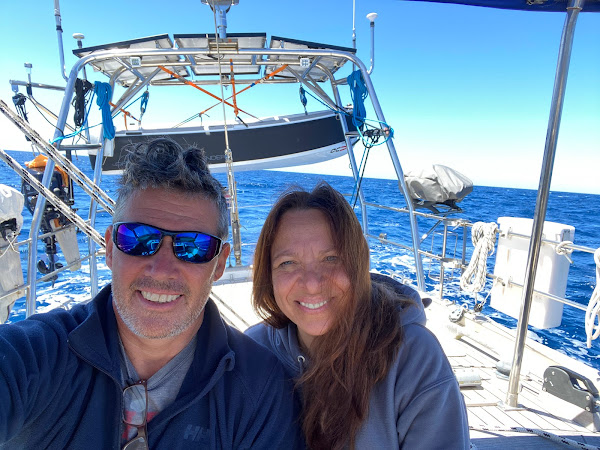Eventually we departed at about 9:30am, still in light winds but forward of the beam so we sheeted the sails in and picked up speed heading east offshore where we caught a bit of the south setting current and headed south and eased the sails for a marvelous beam reach.
We passed Eden at about 3am the following morning in what was a great part of the passage with seas only about 1.5-2.0m and the following current. We were still about 20 miles offshore as we gradually changed course south west and into the infamous Bass Strait. Here is what Wikipedia mentions:
Strong currents between the Antarctic-driven southeast portions of the Indian Ocean and the Tasman Sea's Pacific Ocean waters provide a strait of powerful, wild storm waves. The shipwrecks on the Tasmanian and Victorian coastlines number in the hundreds, although stronger metal ships and modern marine navigation have greatly reduced the danger.
Many vessels, some quite large, have disappeared without a trace, or left scant evidence of their passing. Despite myths and legends of piracy, wrecking and alleged supernatural phenomena akin to those of the Bermuda Triangle, such disappearances can be invariably ascribed to treacherous combinations of wind and sea conditions, and the numerous semi-submerged rocks and reefs within the Straits.
As we entered the Bass Strait the sun started to rise, the apparent wind dropped slightly but the seas were still kindly. As we sailed further into the strait we picked up a 2.5 knot following current. We dared not believe it. We were ticking along at 9.5 knots and at one time hit 10.5 knots this current also flattened the seas but in the back of my mind I knew the current could not only continue but it would likely turn the other way as we progressed. Sure enough during the following evening and night the current dropped and eventually turned against us, thankfully only by 0.75 to 1.00 knots but the seas changed dramatically.
Not only did the seas become steeper the period shortened and we also had two cross seas and a repeating set of 3 large waves that came every ten minutes or so. Then the wind stated to drop along with our apparent wind, which went aft the beam and our boat speed. Now I don’t mind sailing slowly, it’s often very nice to sail slowly at night. On our passage from Noumea we has a couple of days sailing pleasantly along. This however was anything but pleasant with the boat rolling on the seas from different directions which in turn loaded and unloaded the sails. We headed onto the wind to pick up speed and reduce the rolling. This worked slightly but the shifted more NE and we were now heading 40 degrees off course and slowing. We persevered being rolled around on our sleepless watches until dawn came and with it sight of land. Choice: sail slowly on an indirect course too our destination or fire up the engine and be on the anchor by 7 am. Bugger it fire up the engine.
As we sailed past outer and inner sister islands the seas flattened and the wind direction became useful so we raised the sails to complete the rest of the passage to Roydon Island on the north west coast of Flinders island. In fact the final sail was magnificent in the lee of Flinders but still with 15knots on the beam.
We dropped the anchor in the fairly open bay in only 15 feet of water with weed and sand on the bottom. Not a soul or other boat have we seen on the whole passage or in this anchorage. We were very pleased to not be rolling and bucking and put the kettle on. Although the water was flat the anchorage did not provide much protection from the wind and in fact it seemed to blow harder her that outside.
As we arrived early in the morning we had the whole day to relax and plan the next part of our journey and we work our way to Hobart.
We came to the west side of Flinders as it looked like an interesting place to visit and had a few appealing anchorages. We had hoped to get to the Kent Group of islands but the wind direction down the strait prevented us from getting there without another night at sea in uncomfortable conditions. From what we have seen so far Flinders and the islands here are quite barren. We have seen a few houses but have not seen any other boats.

No comments:
Post a Comment